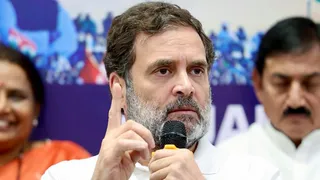- By Deeksha Gour
- Tue, 26 Aug 2025 12:38 AM (IST)
- Source:JND
Bihar News: For long, makhana was just a popular snack in Bihar. It entered politics only when it began appearing in garlands around leaders’ necks. Now, it has taken centre stage in Rahul Gandhi’s campaign. During his Voter Rights Yatra in Katihar, the Congress leader visited makhana fields and interacted with farmers and workers, highlighting their struggles and the dominance of middlemen in the trade.
Rahul Gandhi’s Field Visit
Stepping into a waterlogged field in Seemanchal, Rahul Gandhi observed the process of harvesting makhana. Later, at a local factory, he cracked open the nut himself, learning how much time and labour goes into production. He also examined accounts of costs and profits, realising how little of the earnings actually reach farmers.
Rahul expressed concern over the heavy workload, low wages and lack of modern machines for processing. He said makhana farming, despite being branded a “superfood” business, leaves cultivators with little to survive on.
ALSO READ: Punjab Rains: Schools Closed In These 4 Districts As Swollen Rivers Inundate Many Villages
'Superfood, But Farmers Suffer' Rahul Gandhi
On the same night, Rahul posted on X (formerly Twitter), questioning whether people ever wonder about the source of their favourite superfood.
“Makhana is the result of the blood and sweat of Bihar’s farmers. Sales run into thousands, but income is only in pennies. The middlemen pocket the profits while the farmer remains in pain. Our fight is for justice, workers should earn from their skill and effort,” he wrote.
आपका 'सुपरफूड' मखाना - सोचा है कहां से आता है? कौन, कैसे बनाता है?
— Rahul Gandhi (@RahulGandhi) August 25, 2025
बिहार के किसानों के खून-पसीने का उत्पाद है मखाना- बिक्री हजारों में, मगर आमदनी कौड़ियों में - पूरा मुनाफा सिर्फ़ बिचौलियों का।
हमारी लड़ाई इसी अन्याय के खिलाफ है - मेहनत और हुनर का हक़ मज़दूर को ही मिलना चाहिए। pic.twitter.com/va81K45XDk
He shared videos too, showing conversations with young entrepreneurs and labourers. His friendly tone and curiosity drew positive responses on social media.
Political Calculations Behind Makhana Push
Rahul Gandhi’s renewed interest in makhana farming comes with clear political undertones. His yatra has now entered its third and final phase. After covering Seemanchal, a key makhana belt, the Congress leader will move into Mithilanchal, another major production zone.
Together, these regions hold nearly 70 Assembly seats, 24 in Seemanchal and 46 in Mithilanchal. Seemanchal, with its Muslim-majority population, is viewed as safer political ground for Congress. Mithilanchal, however, poses a tougher challenge due to its complex social equations.
The central government has already announced a Rs 100 crore budget for the Makhana Board, strengthening its own claim to the crop. Rahul’s campaign, therefore, is seen as an attempt to connect with workers emotionally and project Congress as a champion of their rights.
Farmers Speak Out
Local farmers like Madhukar Jha of Narpatganj echo Rahul’s concern. Jha, who cultivated makhana on 1.5 acres, had expected earnings of Rs 3 lakh. But after expenses, he was left with only Rs 70,000. “The crop takes a year, but the profit goes to middlemen,” he lamented.
According to official data, the Bihar government fixes the cost of makhana cultivation at Rs 97,000 per hectare, offering a 75 per cent subsidy under the Makhana Vikas Yojana. On average, eight quintals of raw makhana are harvested per acre, selling at Rs 35,000–Rs 40,000 per quintal.
Once processed, makhana fetches anywhere between Rs 900 and Rs 1,600 per quintal in the retail market. Yet, middlemen often buy from farmers at just Rs 400–Rs 750 per quintal. Experts say if farmers themselves could process and sell directly, their profits would increase by nearly 50 per cent.
Rahul’s Closing Message
Reiterating his stance, Rahul Gandhi wrote: “Our fight is against injustice. The worker should have the right to earn for his skill and hard work.”
